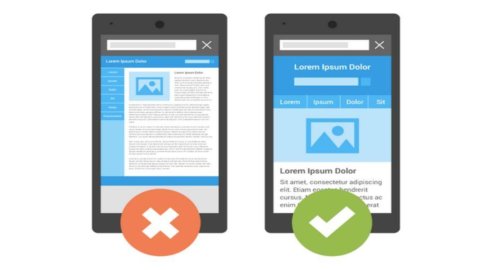The most famous and used search engine in the world changed the rules to climb its unique ranking of search results. They are rules for reward who created web pages suitable for navigation da smartphone o tablets.
It is not a sudden change, let alone a radical one. Already at the end of 2014, on Google's official blog, it was stated that there would have been an adjustment to the prevailing method of use of the search engine by users, i.e. increasingly on the move rather than from a fixed location.
Google is very attentive to the type of experience it offers to surfers and rarely lags behind new needs. Not surprisingly, every year, the changes to its algorithm are around 500/600 (on average), even if most of the time they are small variations. Only what the technicians call "major updates" makes news, to which Google gives curious names that are difficult to logically associate with the changes made (Panda, Penguin, Pirate, Pigeon, Hammingbird or Panda, Penguin, Pirate, Pigeon or Hummingbird , just to name a few).
The list of the main changes of the Google algorithm from 2000 to today, can be consulted on site of an SEO consultancy company, very attentive to the aspects related to positioning, which has collected all the information, bare and raw, without interpretations of any kind, which Google itself has provided over the years to all professionals.
Therefore, it is not a question of confidential or declassified information, on the contrary, Google technicians are very generous with advice through official channels (Blog, Academy, Insight, Developers), but it is too often those who would like to give a distorted reading of these messages bend the directives of the manager of the largest information search machine on the web to his own idea of the Internet.
In these cases, however, following the instructions without going any further leads to a better understanding of the dynamics that underlie the interaction between real and virtual society: surfers' habits change according to technological progress, but it is also true that it is the same technology to shape itself on the methods used by users to access information.
This guide does nothing but explain in simple and direct terms, what everyone could read about Google's official blog (knowing some English). We start from the assumption that all the novelties of the algorithm they concern only and exclusively the search via smartphone and tablet. Therefore, using a desktop or laptop computer for a Google search will lead to the exact same results as before.
It must be said that the “mobile-friendly” badges, added by Google in November to those resources optimized for browsing from mobile devices, in the search results list (SERP), it is not related to the entire site that hosts that particular resource, but only to the page in question. This means that if a site is not fully optimized for browsing from smartphones or tablets, but one of its pages is, then the latter will be enhanced and will have the Google "mobile friendly" page identification badge.
All sites that cannot bear the Google recognition badge however, they will not disappear from the list. Indeed, if a page has content that best responds to a user's request by keyword, regardless of the predisposition to mobile navigation, that result will remain high in the SERP.
Furthermore, a site processed by Google robots and labeled as "non-mobile friendly" will frequently undergo new analyzes of its pages to take into account any adjustments.
What must be done in order not to lose positions, then?
The first rule is to put yourself in the visitor's shoes. The screen of a mobile device is undoubtedly limited compared to that of a laptop or desktop computer, therefore it is necessary to take this into account and arrange the contents in such a way that they do not come out of the dimensions of the screen of a mobile phone or at most of a tablet. Because having to scroll the text horizontally, as well as vertically, is certainly not pleasant. The solution to this problem is in a relatively new technology that goes by the name of “responsive website design” or the ability of a web page to adapt by itself to the different screens on which it is displayed.
The second rule is to not make links too close to each other. Even those with very small fingers risk touching the smartphone incorrectly if the selectable parts are too close together. Solving with a preventive zoom on the section of the site you are interested in always represents a boring extra movement.
The third rule it is actually also common to browsing in the desktop version and that is the use of legible font sizes. Here, there is little to add other than being careful to choose, on the occasion, even a font that has well-defined and unmistakable letters, numbers and punctuation.
How to fourth directive there is certainly that of not using plug-ins that a smartphone may not be able to manage or not exploit. For example, the JavaScript language and those style sheets (CSS) that block the display of contents "above the fold", ie those visible without the user having to use the scroll bar or the mouse wheel.
Fifth tip by Google: do not load content that is too heavy or structures that are too complex such as high definition images or videos that automatically play. Therefore, prefer elements that are active on-demand and that do not force devices to directly download all the components of the page.
How to sixth rule, also take a look at the text: the law is "to minimize resources" and means the elimination of superfluous bytes, such as line breaks, indents and extra spaces. Not to mention empty pages or those with redundant code that also makes navigation unpleasant.
Seventh: if a site uses an HTTP redirect, i.e. if its home page has links for sections/versions of its pages, it is important to make a single reference and not go through a tree of useless subdivisions. Furthermore, Google considers it important that a tag is included in the code of desktop pages to identify the equivalent address for mobile devices. In this way, the Google robot will not have to struggle to identify all the "mobile-friendly" pages.
THEoctave and the last rule is a little more technical. It's about compressible resources on the page using HTTP compression. Simply put, Google would like you to avoid using add-ons, third-party modules, or site-embedded routines when using the ability of some web servers to compress files before making them available for download. This procedure can in fact reduce the amount of time required to download the necessary resources and render the website.
It must be said that, unlike in the past, the changes will be active immediately for searches made all over the world. So not a first test only in the United States and a gradual adjustment by geographical area, but a universal modification that will affect all the results proposed on the screens of smartphones and tablets in every part of the globe.





